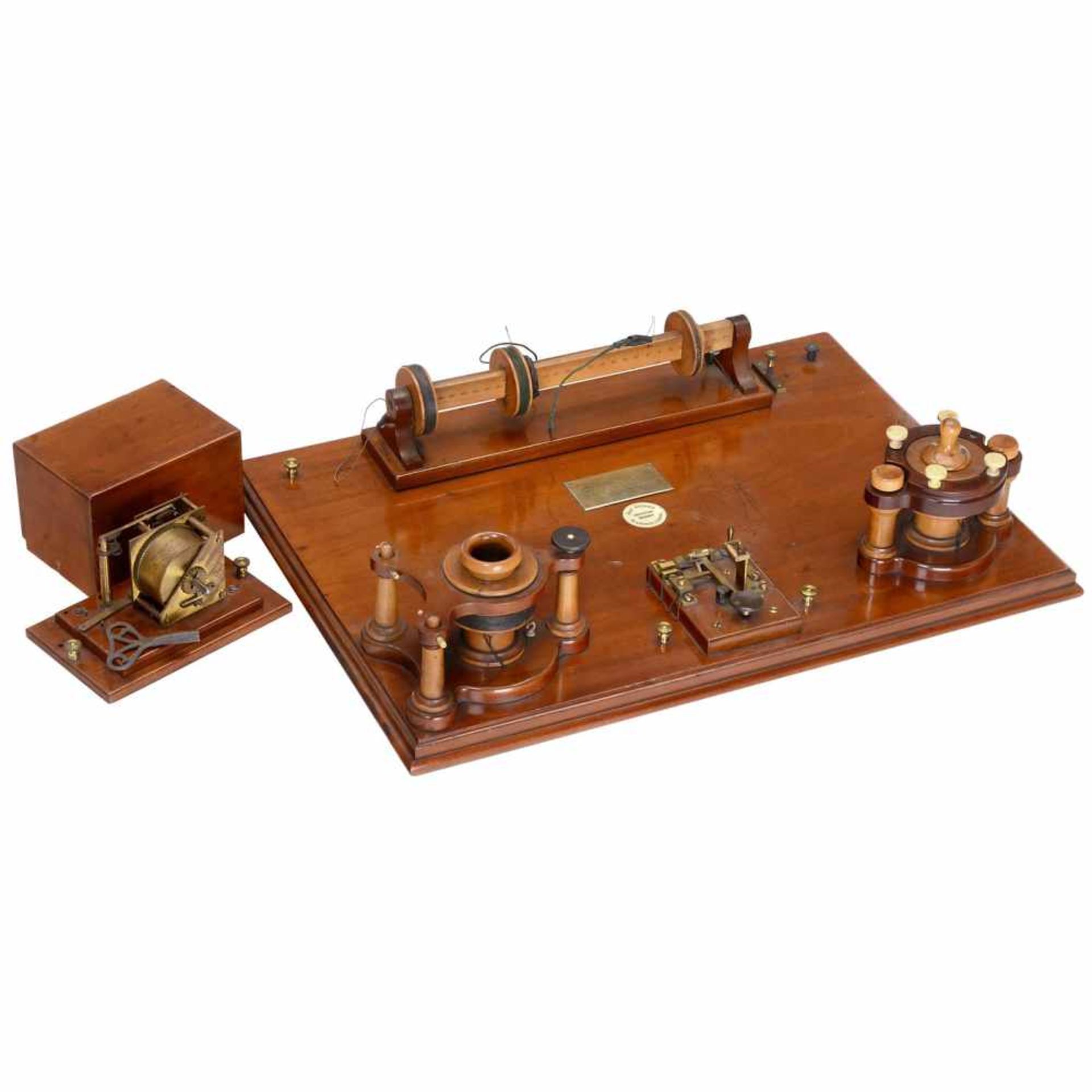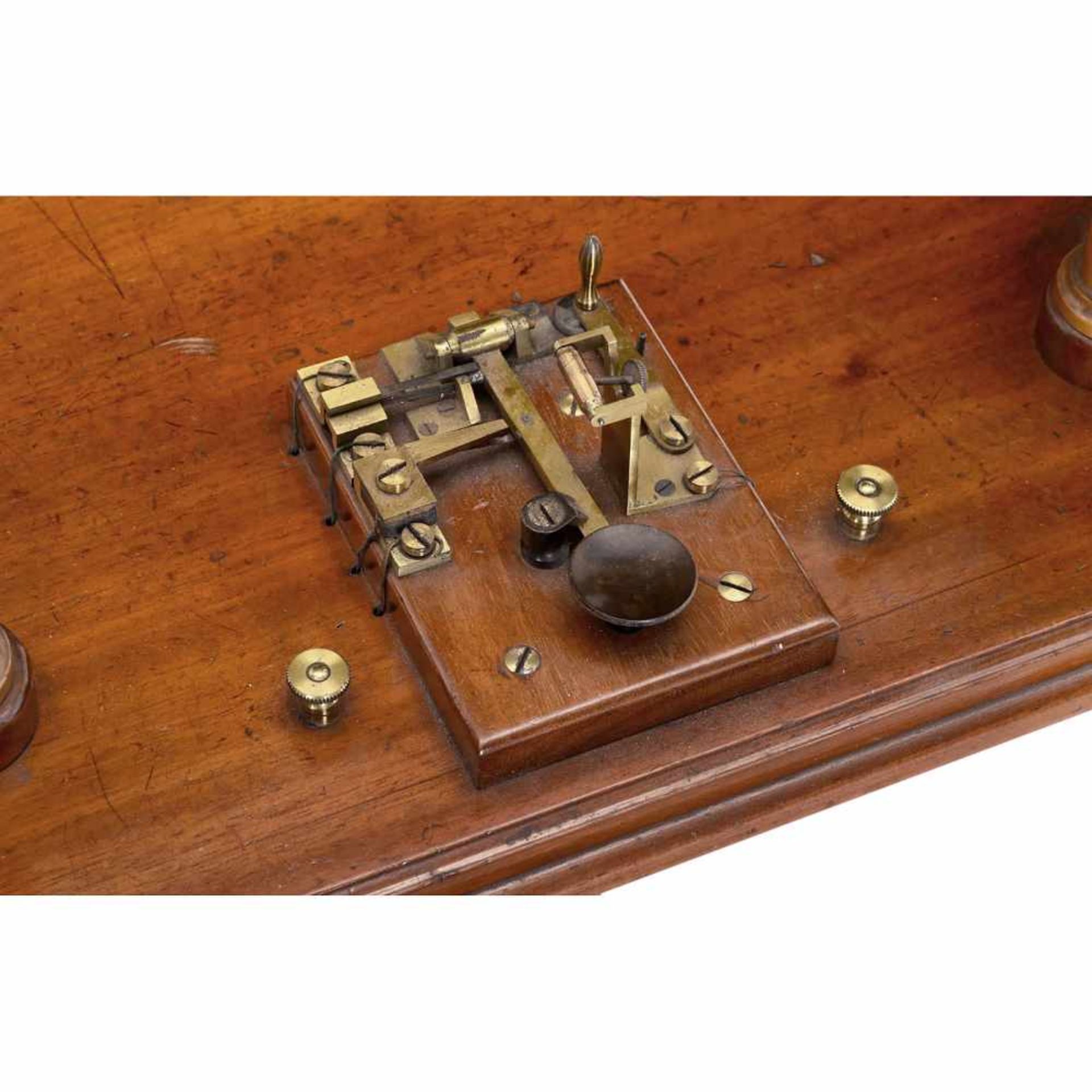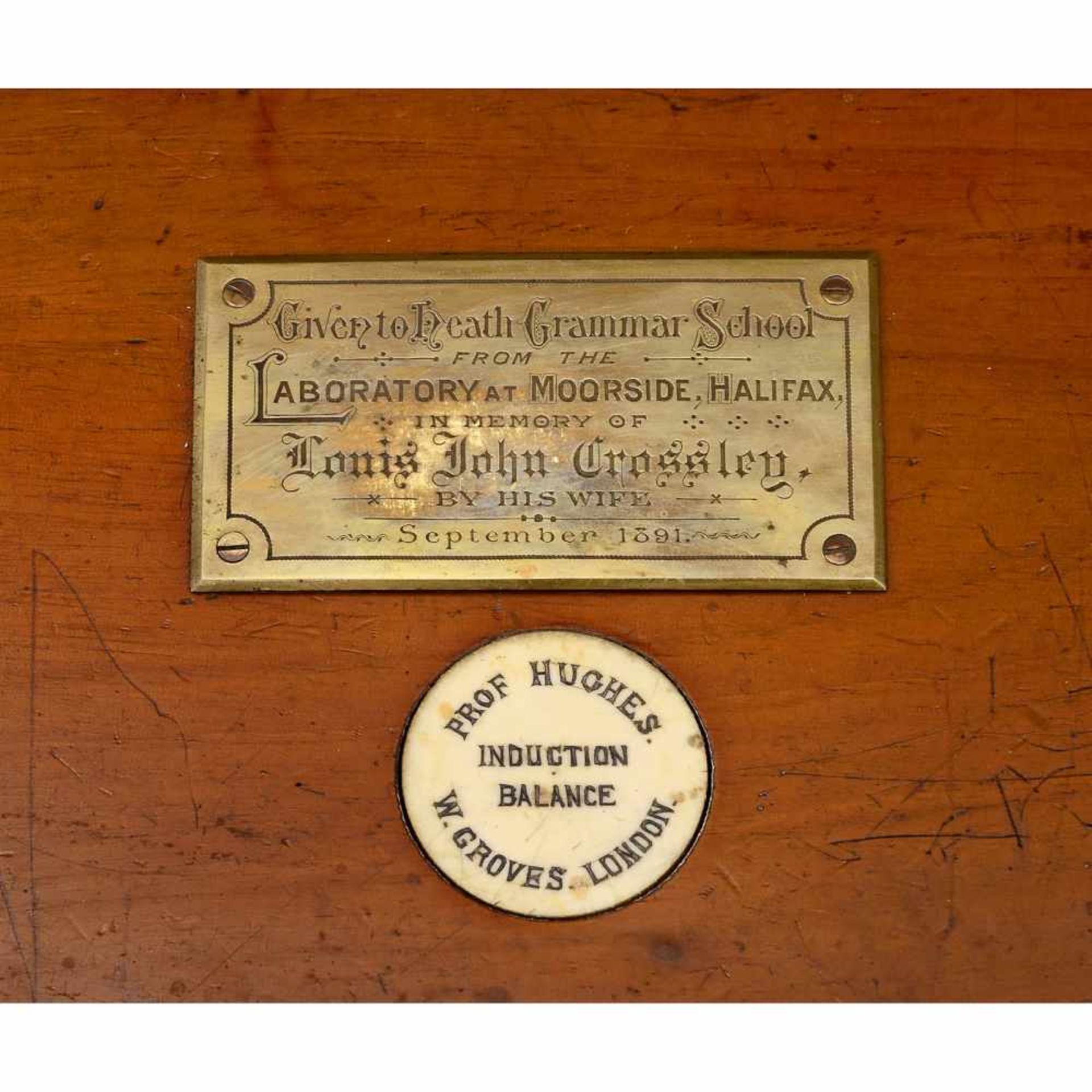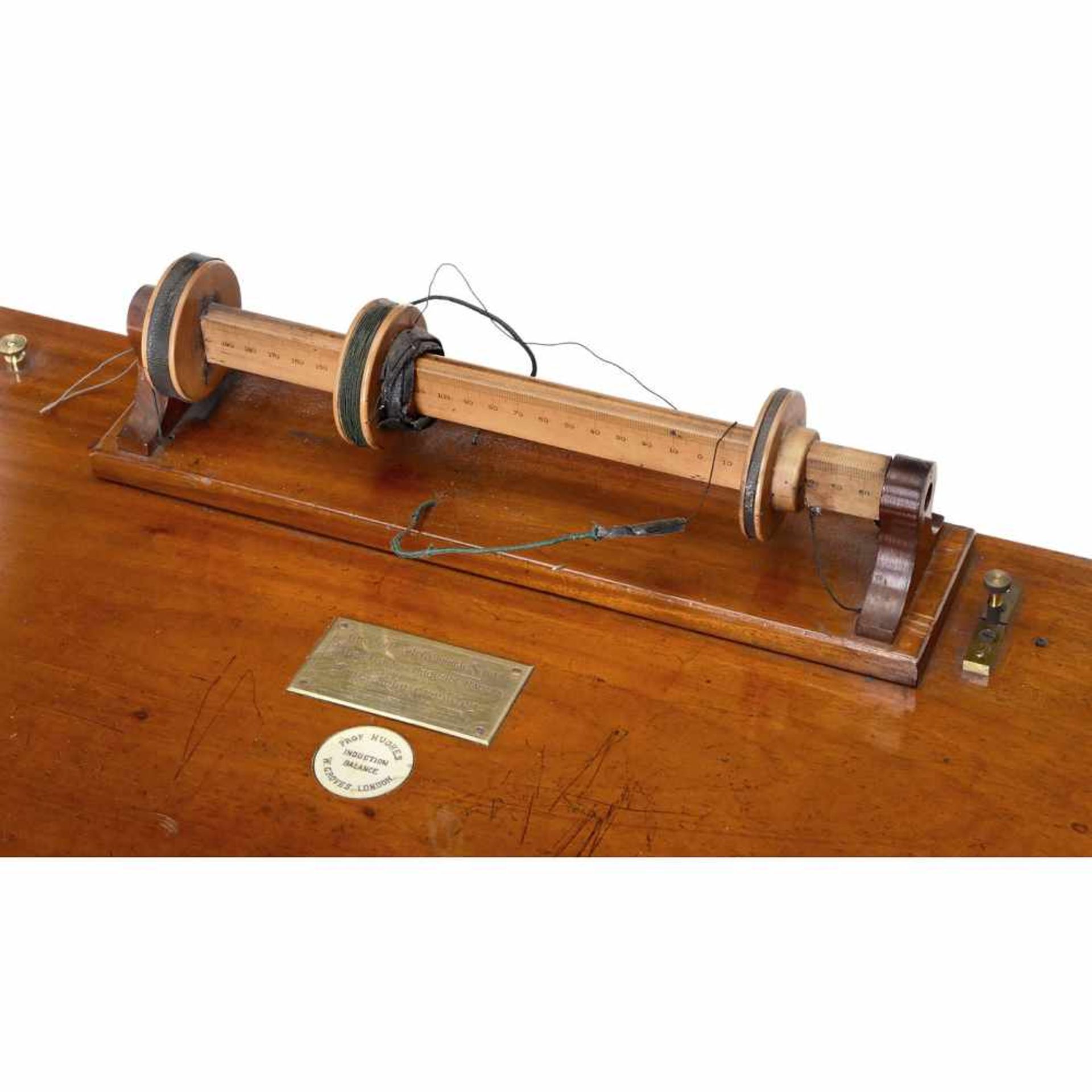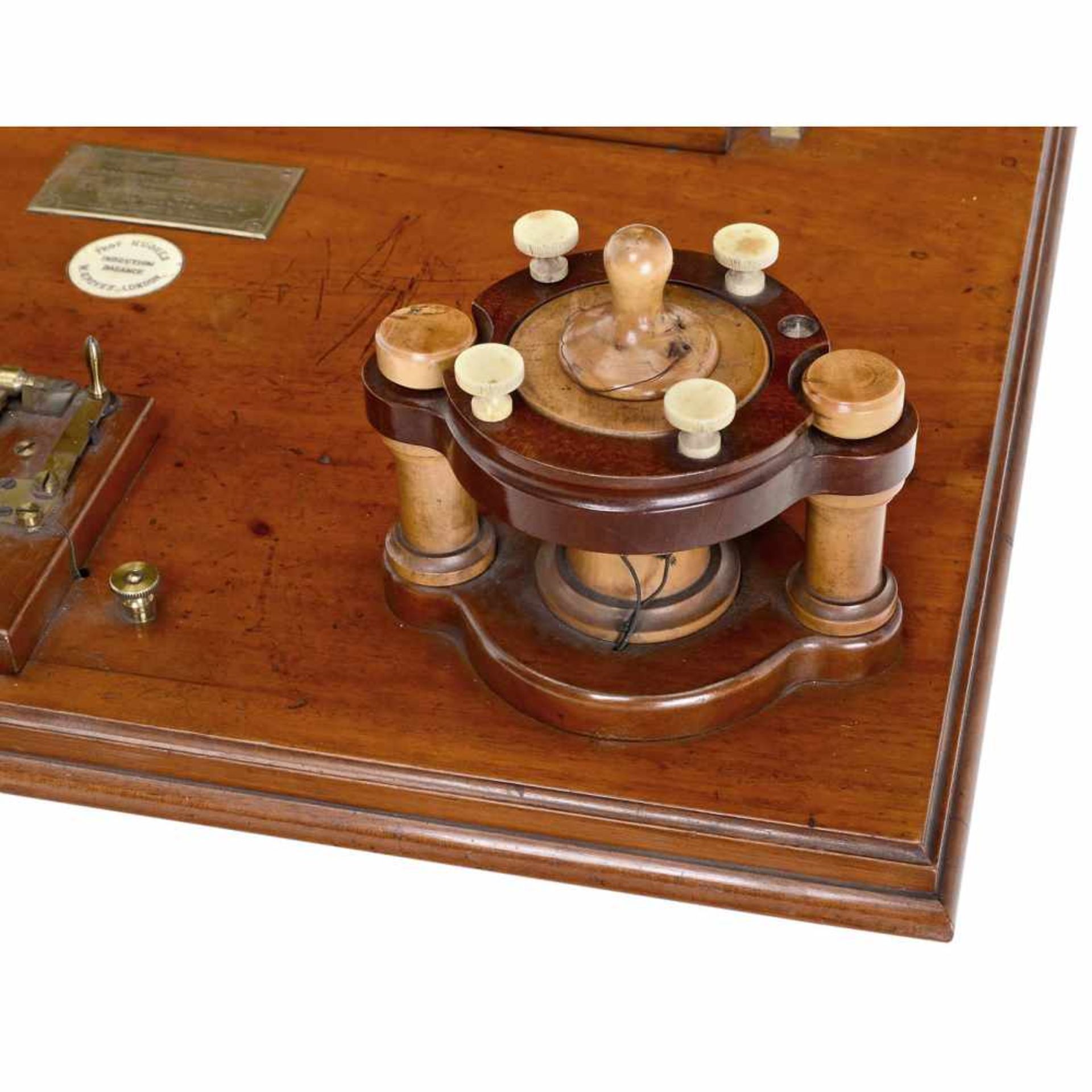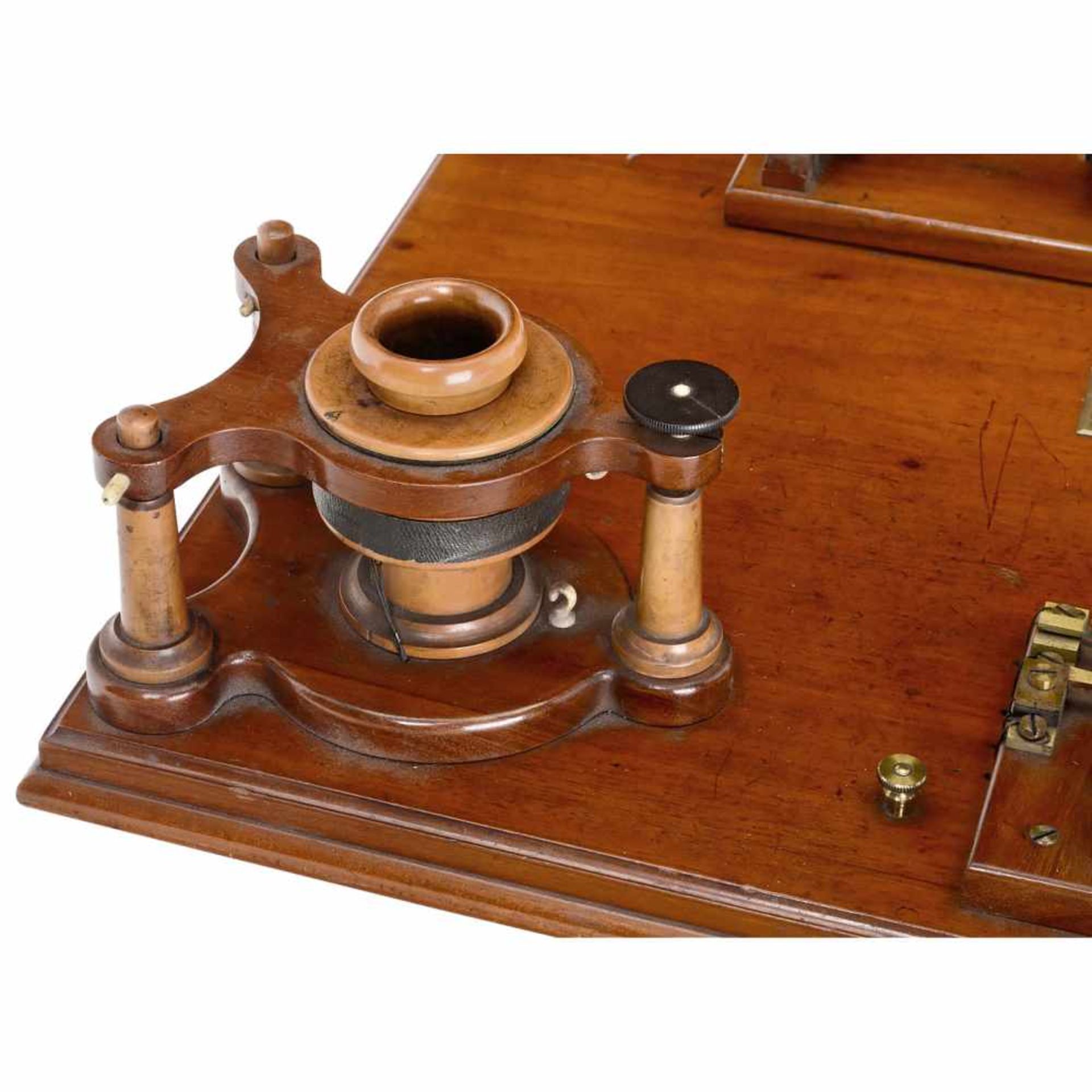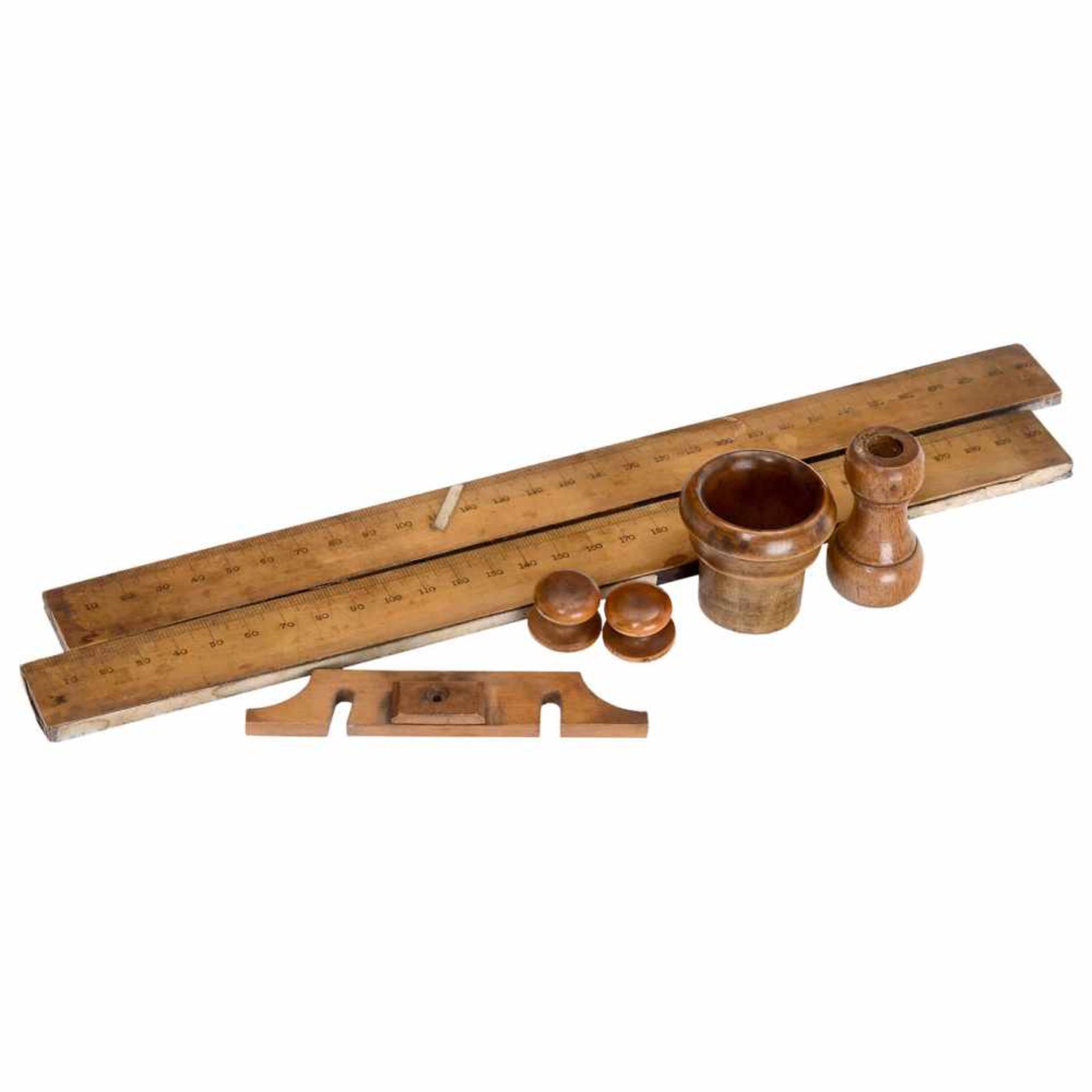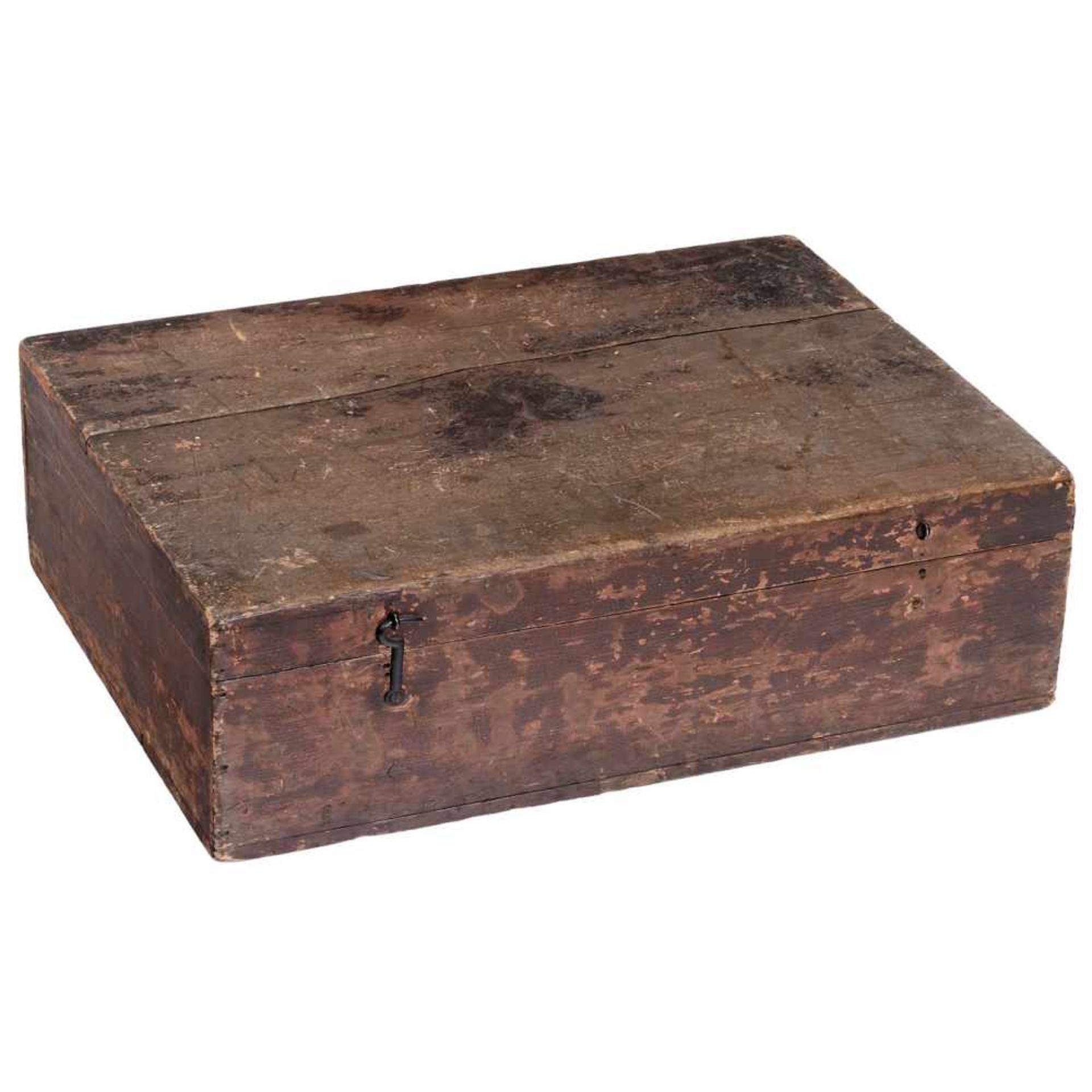35
Hughes Induction Balance, 1879Laboratory instrument, made by W. Groves, London. With inscription
Hughes'sche Induktionswaage, 1879
Laborgerät, hergestellt von W. Groves, London. Mit Widmung auf Messing-Plakette "Given to Heath Grammar School from the Laboratory at Moorside, Halifax, in memory of Louis John Crossley by his Wife, September 1891". - Bestehend aus: elektrischer Stromwaage, Sonometer, Mikrophon-Taster, 2 verschiebbaren Skalen, Spulen und Uhrwerk mit Unterbrecher-Kontakt, aus Mahagoni, Bein und Messing, auf Mahagoni-Brett, Maße 54,5 x 39,5 cm. Mit maschinengeschriebener englischer Beschreibung dieses Instruments aus dem Jahr 1904. In dazugehörendem Holzkasten. - Berichte zur Hughes'schen Induktionswaage wurden 1879 in "The Telegraphic Journal" und in "The Illustrated London News" veröffentlicht.
Condition: (2-3/-)
Hughes Induction Balance, 1879
Laboratory instrument, made by W. Groves, London. With inscription on brass plaque "Given to Heath Grammar School from the Laboratory at Moorside, Halifax, in memory of Louis John Crossley by his Wife, September 1891". - With typed description from 1904: "This commercial example of the Induction Balance is similar in general characteristic to the adjacent experimental form, but is provided with a few long thin wedges of zinc which can be used instead of the sonometer to balance the inductive effect of the specimen disk. After the balance coils have been adjusted so that no sound is heard in the secondary receiver circuit, a specimen disc is inserted in one secondary coil, and disturbs the balance. A zinc strip is then placed in a groove above the other secondary and is moved in the groove until the balance is re-established, when no sound is again heard in the receiver. The thickness of the zinc strip varies uniformly from one end to the other, so that its inductive effect depends purely on the position of the secondary coil with respect to one end of the strip. A corresponding tapering wooden rule is provided for each zinc strip, the two together forming one strip of uniform thickness, so that the position of the zinc can be ascertained from that from the rule. A sonometer arrangement similar to that on the original model is also provided, and a microphone, clockwork interrupter and a telephone receiver such as were employed with the apparatus are exhibited with it." - Inv. 1904- 62, 63,64,65. - Made of mahogany, bone and brass, size of the board 21 ½ x 15 ½ in. With induction currents balance, electric sonometer, 2 sliding scales to fit over balance coil, clockwork interrupter and microphonic key. In fitted wood case. Various reports about this invention came out in 1879, published in "The Telegraphic Journal" and in "The Illustrated London News".
Zustand: (2-3/-)
Hughes'sche Induktionswaage, 1879
Laborgerät, hergestellt von W. Groves, London. Mit Widmung auf Messing-Plakette "Given to Heath Grammar School from the Laboratory at Moorside, Halifax, in memory of Louis John Crossley by his Wife, September 1891". - Bestehend aus: elektrischer Stromwaage, Sonometer, Mikrophon-Taster, 2 verschiebbaren Skalen, Spulen und Uhrwerk mit Unterbrecher-Kontakt, aus Mahagoni, Bein und Messing, auf Mahagoni-Brett, Maße 54,5 x 39,5 cm. Mit maschinengeschriebener englischer Beschreibung dieses Instruments aus dem Jahr 1904. In dazugehörendem Holzkasten. - Berichte zur Hughes'schen Induktionswaage wurden 1879 in "The Telegraphic Journal" und in "The Illustrated London News" veröffentlicht.
Condition: (2-3/-)
Hughes Induction Balance, 1879
Laboratory instrument, made by W. Groves, London. With inscription on brass plaque "Given to Heath Grammar School from the Laboratory at Moorside, Halifax, in memory of Louis John Crossley by his Wife, September 1891". - With typed description from 1904: "This commercial example of the Induction Balance is similar in general characteristic to the adjacent experimental form, but is provided with a few long thin wedges of zinc which can be used instead of the sonometer to balance the inductive effect of the specimen disk. After the balance coils have been adjusted so that no sound is heard in the secondary receiver circuit, a specimen disc is inserted in one secondary coil, and disturbs the balance. A zinc strip is then placed in a groove above the other secondary and is moved in the groove until the balance is re-established, when no sound is again heard in the receiver. The thickness of the zinc strip varies uniformly from one end to the other, so that its inductive effect depends purely on the position of the secondary coil with respect to one end of the strip. A corresponding tapering wooden rule is provided for each zinc strip, the two together forming one strip of uniform thickness, so that the position of the zinc can be ascertained from that from the rule. A sonometer arrangement similar to that on the original model is also provided, and a microphone, clockwork interrupter and a telephone receiver such as were employed with the apparatus are exhibited with it." - Inv. 1904- 62, 63,64,65. - Made of mahogany, bone and brass, size of the board 21 ½ x 15 ½ in. With induction currents balance, electric sonometer, 2 sliding scales to fit over balance coil, clockwork interrupter and microphonic key. In fitted wood case. Various reports about this invention came out in 1879, published in "The Telegraphic Journal" and in "The Illustrated London News".
Zustand: (2-3/-)
Science & Technology, Mechanical Music, Fine Toys & Automata
Auktionsdatum
Ort der Versteigerung
Generelle Versandinformationen vom Auktionshaus verfügbar
Local Pick-Up, In-House Shipping
Wichtige Informationen
Nothing important.
AGB
standard | standard
Auction conditions
1) The auction is carried out voluntarily under foreign name and on account of the customer.
2) The goods to be sold in the auction can be examined and checked at determined times before the auction – under the full responsibility and risk of the interested client. They will be put up for auction in the condition as they are without any liability for visible or hidden defects as well as for attributes; later claims of any kind cannot be taken into consideration. The descriptions in the catalogue are made to the best of our knowledge, but they are no guaranteed attributes in the sense of § 459 and following BGB. – Information ref. § 26 UStR is assured. – No right of return of any sold item, therefore please use the advantage of the previewing (also by your friends).
3) Normally the bids are increased in steps of 10 % of the initial price with a minimum of € 5.–. The auctioneer can deviate from this regulation in particular cases. The knocking down is done if no higher offer is made after the third repetition of the highest offer and if the limit price has been achieved.
4) The auctioneer can combine numbers, separate them, can offer them out of the sequence or can withdraw them. The bidding is done by showing the bidding number or by a written offer.
5) The auctioneer can refuse an offer; in this case the offer given right before remains binding. In case several per¬sons make the same offer, the knocking down is decided by lot. In case of identical written offers, the computer makes the decision to the benefit of the first offer received. Decisive in this case is the point of time of its entry. If there is a disagreement on a knocking down or if an offer is made in time has been dis¬regarded, the auctioneer can all the same knock down this bid and can follow-up the rights resulting out of this. He can also knock down to the next lowest bid or can start again with the initial bid of this lot.
6) The knocking down is binding. The goods must be im-mediately paid. The knocking down transfers the risk of possible losses, damages, mistakes to the purchaser. Each bidder buys in his own name and for his own account.
7) A premium of 21,8 % has to be paid on the knocking down price. The tax (19 %) has to be paid on the surcharge, i.e. the total surcharge amounts to 25,94 %. The entire amount, which has to be paid by the purchaser, is immediately due and has either to be settled in cash, wire transfer or by guaranteed bank draft. In case of an acquisition by submittance of a written order, the pay¬ment has to be settled within 8 days after the invoice date.
8) The goods become the property of the purchaser only after the complete payment. The objects will only be delivered if the payment has been settled. Otherwise the goods are still the property of the consigner until complete payment. In case a payment does not reach the auctioneer in due time, the purchaser is liable without reminder for all resulting losses. Also without proof of a loss the interest for delay at the bank usual rate can be charged.
9) In case the payment is not settled in time or the objects are not taken, the auctioneer has the right either to demand the performance of the contract of purchase or can claim damages due to the non-performance. Independent from the above the auctioneer can also put this object for auction in one of the next auctions on cost of the purchaser. For the resale in the auction the bidder is treated as supplier and has to pay the corresponding or¬der commission as well as the tax to be paid on it. All transportation and storing costs as well as possible charges for the employment of additional workers, which result in connection with the above, will be de¬ducted from the net profits. The remaining profit will be balanced on the date of the actual inpayment with the claim for damages acc. to § 367 BGB.
10) The handing over of the objects bought in the auction is done at any time during and after the auction against presentation of the receipt. Invoices issued immediately after the auction are subject to the right of verification and possible corrections: errors excepted.
Bidders who are present at the auction must arrange the pick-up on the day of the auction. Otherwise the objects will be stored on account and risk of the purchaser without any further notice. The auctioneer does not bear the risk of storing.
11) Each shipment is carried out on the account and risk of the purchaser. Insurance possible on request.
12) Bidder orders are handled with great care; a guarantee for its setting up for auction can only be ensured if the written bidding order has reached the auctioneer latest at 12:00 am (noon) two days before the auction. The bidders un-known to the auctioneer are kindly asked to provide a satisfactory security before the auction.
13) The legal relation is based on the German law. Place of performance and legal venue for the mutual trade busi-ness is Cologne.
14) The visitor accepts the above conditions explicitly by his participation in the auction or by his offer.
Auction Team Breker
– Astrid & Uwe Breker –
Currency exchange rates (1 February 2018): 1 € (Euro) = approx. US$ 1,24 / £ 0,88 / ¥en 135


















